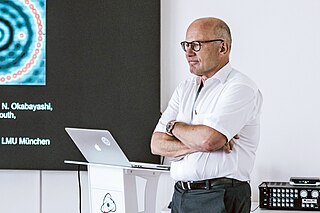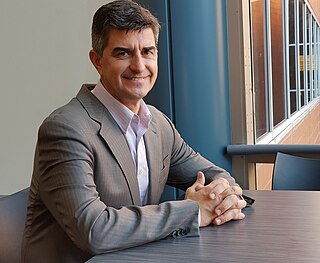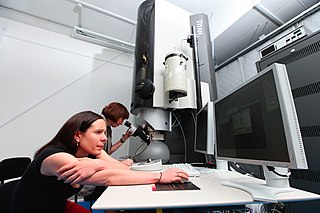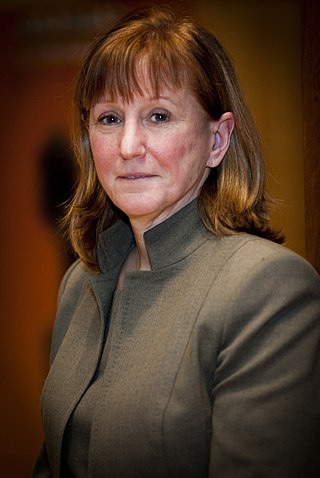
Nanotechnology was defined by the National Nanotechnology Initiative as the manipulation of matter with at least one dimension sized from 1 to 100 nanometers (nm). At this scale, commonly known as the nanoscale, surface area and quantum mechanical effects become important in describing properties of matter. The definition of nanotechnology is inclusive of all types of research and technologies that deal with these special properties. It is therefore common to see the plural form "nanotechnologies" as well as "nanoscale technologies" to refer to the broad range of research and applications whose common trait is size. An earlier description of nanotechnology referred to the particular technological goal of precisely manipulating atoms and molecules for fabrication of macroscale products, also now referred to as molecular nanotechnology.

Sumio Iijima is a Japanese physicist and inventor, often cited as the inventor of carbon nanotubes. Although carbon nanotubes had been observed prior to his "invention", Iijima's 1991 paper generated unprecedented interest in the carbon nanostructures and has since fueled intense research in the area of nanotechnology.

The Department of Materials at the University of Oxford, England was founded in the 1950s as the Department of Metallurgy, by William Hume-Rothery, who was a reader in Oxford's Department of Inorganic Chemistry. It is part of the university's Mathematical, Physical and Life Sciences Division

Nanometrology is a subfield of metrology, concerned with the science of measurement at the nanoscale level. Nanometrology has a crucial role in order to produce nanomaterials and devices with a high degree of accuracy and reliability in nanomanufacturing.
The following outline is provided as an overview of and topical guide to nanotechnology:
Knut W. Urban is a German physicist. He has been the Director of the Institute of Microstructure Research at Forschungszentrum Jülich from 1987 to 2010.

Ondrej L. Krivanek is a Czech/British physicist resident in the United States, and a leading developer of electron-optical instrumentation. He won the Kavli Prize for Nanoscience in 2020 for his substantial innovations in atomic resolution electron microscopy.

George Andrew Davidson Briggs is a British scientist. He is Professor of Nanomaterials in the Department of Materials at the University of Oxford. He is best known for his early work in acoustic microscopy and his current work in materials for quantum technologies.

Franz Josef Gießibl is a German physicist and university professor at the University of Regensburg.

Yury Georgievich Gogotsi is a Ukrainian scientist in the field of material chemistry, professor at Drexel University, Philadelphia, United States since 2000 in the fields of Materials Science and Engineering and Nanotechnology. Distinguished University and Trustee Chair professor of materials science at Drexel University — director of the A.J. Drexel Nanotechnology Institute.

Sergei V. Kalinin is a corporate fellow at the Center for Nanophase Materials Sciences (CNMS) at Oak Ridge National Laboratory (ORNL). He is also the Weston Fulton Professor at the Department of Materials Science and Engineering at the University of Tennessee-Knoxville.

The characterization of nanoparticles is a branch of nanometrology that deals with the characterization, or measurement, of the physical and chemical properties of nanoparticles. Nanoparticles measure less than 100 nanometers in at least one of their external dimensions, and are often engineered for their unique properties. Nanoparticles are unlike conventional chemicals in that their chemical composition and concentration are not sufficient metrics for a complete description, because they vary in other physical properties such as size, shape, surface properties, crystallinity, and dispersion state.
Arup Kumar Raychaudhuri is an Indian condensed matter physicist, materials scientist and a Distinguished Emeritus Professor at the S. N. Bose National Centre for Basic Sciences. Known for his pioneering work on the interplay of disorder and interaction, Raychaudhuri is an elected fellow of all the three major Indian science academies viz. Indian Academy of Sciences, National Academy of Sciences, India and Indian National Science Academy as well as the Asia-Pacific Academy of Materials. He is a recipient of a number of awards such as Millennium Medal of the Indian Science Congress, ICS Gold Medal of the Materials Research Society of India and FICCI Award. The Council of Scientific and Industrial Research, the apex agency of the Government of India for scientific research, awarded him the Shanti Swarup Bhatnagar Prize for Science and Technology, one of the highest Indian science awards, for his contributions to physical sciences in 1994.

Andreas J. Heinrich is a physicist working with scanning tunneling microscopy, quantum technology, nanoscience, spin excitation spectroscopy, and precise atom manipulation. He worked for IBM Research in Almaden for 18 years, during which time he developed nanosecond scanning tunneling microscopy which provided an improvement in time resolution of 100,000 times, and combined x-ray absorption spectroscopy with spin excitation spectroscopy. In 2015 his team combined STM with electron spin resonance, which enables single-atom measurements on spins with nano-electronvolt precision REF1, REF2. In 2022 his team demonstrated the extension of ESR-STM to individual molecules REF3. Heinrich was also principal investigator of the stop-motion animated short film A Boy and His Atom filmed by moving thousands of individual atoms. He is a fellow of the American Physical Society and the American Association for the Advancement of Science and the recipient of the Heinrich Rohrer Medal of the Japan Society of Vacuum and Surface Science.

Sarah Jane Haigh is a Professor in the School of Materials at the University of Manchester. She investigates nanomaterials using transmission electron microscopy, including two-dimensional materials such as graphene.

Yi Cui is a Chinese-American materials scientist, specializing in nanotechnology, and energy and environment-related research. Cui is the Fortinet Founders Professor of Materials Science and Engineering, and by courtesy, of Chemistry at Stanford University. He currently serves as the director of the Precourt Institute for Energy, succeeding Arun Majumdar and Sally Benson. He has been named the inaugural faculty director of the Sustainability Accelerator within the Stanford Doerr School of Sustainability. He also serves as a co-director of the Bay Area Photovoltaics Consortium, the Battery500 Consortium, and the StorageX initiative. He is a faculty member of Stanford Photon Science of SLAC, principal investigator at the Stanford Institute for Materials & Energy Sciences, and a senior fellow at Stanford Woods Institute for the Environment. He is an elected member of the National Academy of Sciences and European Academy of Engineering, and Fellow of the American Association for the Advancement of Science (AAAS), Materials Research Society (MRS), Electrochemical Society (ECS), and the Royal Society of Chemistry (RSC). He has been one of the world's most-cited researchers and most influential scientific minds. He has published over 806 research papers with an H-index of 267. He currently serves as the Executive Editor of Nano Letters from ACS Publications.

Dawn Austin Bonnell is the Senior Vice Provost for Research at the University of Pennsylvania. She has previously served as the Founding Director of the National Science Foundation Nano–Bio Interface Center, Vice President of the American Ceramic Society and President of the American Vacuum Society.
Elisa Riedo is a physicist and researcher known for her contributions in condensed matter physics, nanotechnology and engineering. She is the Herman F. Mark Chair Professor of Chemical and Biomolecular Engineering at the New York University Tandon School of Engineering and the director of the picoForce Lab.

Robert Andrzej Varin is a Polish-Canadian scientist, Professor of technical sciences, specialist of materials science and engineering.

The "Centre d’Élaboration de Matériaux et d’Etudes Structurales" (CEMES) is a CNRS laboratory located in Toulouse, France.
















